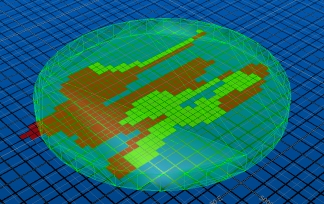|
|
Command Help |
|
Command Name |
Menu |
Quick Key |
Link to Command Table |
|
evaluate-wireframe |
evw |
Description
Evaluate above or below DTM or within a wireframe volume.
How to use
- Run the command.
- The Evaluate Wireframe dialog is displayed.
- Ensure the require wireframe object is selected. If it is not, use the drop-down list to select a wireframe, or use the Pick tool to interactively select a wireframe object in the data window.
|
|
Your wireframe selection settings will be temporarily disabled if they are set to any setting other than 'select by object'. On completion of the wireframe selection, original wireframe selection settings are reinstated. |
- Specify if the wireframe you wish to evaluate is a DTM or if it is closed. Note the same wireframe files can contain more than one closed wireframe model and more than one DTM. Evaluations in this case should be done by specifying a wireframe filter.
- If the wireframe is a DTM you are asked if you wish to evaluate above or below the DTM. You are then asked to enter an elevation to define the limit of evaluation. If evaluating above the DTM the default elevation is the maximum Z coordinate in the wireframe. If evaluating below the DTM the default elevation is the minimum Z coordinate in the wireframe.
- Using the Evaluate Wireframe dialog, assign a Mining Block ID to the wireframe so it can be given a reference in the results file. If the evaluation is accepted the triangles in the wireframe files will be given this BLOCKID value.
-
Set a Default Density value: this will be used if a Density field does not exist in the input model, or it exists and absent values are found. By default, this is 1.

The Default Density setting persists between the static evaluation commands, but can be adjusted in any of them, if appropriate.
-
Click OK to display the Evaluation Results panel. This shows the tonnes and volume for each distinct string entity. By default, each string is reported as a separate block of results, but these can be combined using the Combine Block Results command.
- Results are reported using the Evaluation Results panel.
- You can (optionally) Save your results to a Datamine-format results file and/or Excel format.
- Wireframe triangles are updated with the BLOCKID value. All previous references to the BLOCKID in the results file is erased.
|
|
It is necessary to write the wireframe to file at some stage before exiting your application in order to store this BLOCKID value in the current wireframe files. This is most easily done using the write-wf-data command. A comparison of the total volume of the cells within the wireframe and the volume of the wireframe is made. If the difference between these two figures is more than 2 percent of the volume of the cells a warning is given. An example of when this would occur is if all or part of the wireframe is outside the limits of the cell model. If any cell contains an absent density value the default density is used. This default value is defined when the cell model file is opened. |
|
|
If absent grade values are found, then they are replaced by the average value for the grade and a message is displayed in the Output window. |
|
|
Related Topics |
|
|
Evaluation
Commands - Results Table
Evaluation - Reports |


